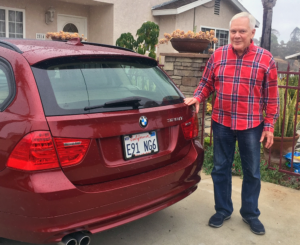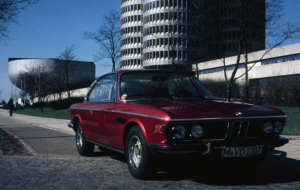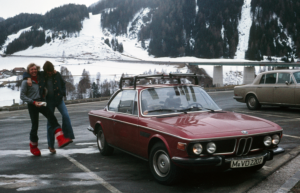To those who don’t know me already, I’m an automotive journalist who first became Technical Editor of Road & Track magazine in 1965, then Engineering Editor, then Editor, then European Editor, then a freelancer trying to contribute what I could to R&T and other car mags in other countries. Most recently I was a writer, editor and consultant for BMW of North America, creating much of the training material for dealership personnel from the mid-1980s on. But before all that:

As a kid growing up in a small East Texas town in the early post-World War II years, I was blessed to have a father who was a car mechanic, paint-and-body artist and – eventually a car dealer.
At that time, all the cars we ordinary folk knew were American. But there were kids like me who bought “car mags” like Road & Track, and learned that not all cars were American.
Thanks to the war’s outcome, most of the cars U.S. military personnel brought home from Europe were not German. British marques were especially popular. Thumbing through my 1955 volume of Road & Track issues, I find no road tests or major features on BMW cars. However, BMW was rebuilding; indeed the December ’55 issue announced the sensational 507 roadster, and in that issue’s classified ads was a “BMW 55-328 roadster,” whatever that was.
Meanwhile, back in Mineola
I kept reading those R&T issues and my ever-supportive dad was always ready to support me with purchases, maintaining and even customizing them. In high school, I bought Mineola’s first “foreign” car, an MG TD. But after a couple of years, it was sold to help pay for my first year at Southern Methodist University, where I was going to study Mechanical Engineering.
My first BMW sighting – at FoMoCo!
For four of the five years in the engineering course, I worked at Ford Motor Co.’s engineering center in Dearborn, Michigan: This was SMU’s “cooperative” program, which found part-time jobs for engineering students to give them early job training and help pay their way through college.
Upon my graduation, Ford afforded me a regular job in that engineering center; soon this cub engineer was getting experience in actual vehicle development. One of my early assignments was on the ’55 Fords and Mercurys, including a cross-country trip in disguised prototypes to the company’s Arizona proving ground.
During that trip, I got my first look at California – and the Road & Track offices in Newport Beach. The rest, as they say, is history.
Every carmaker – well, at least the major ones – purchase or rent competitive vehicles for reference, target-setting and market knowledge. Ford kept these vehicles in what was called the Reference Garage. It won’t surprise anyone that I, the cub engineer, often took a stroll through that garage on my coffee break.
Still reading those car mags, I’d learned about BMWs – specifically the Neue Klasse 1500. And there, in that garage, was a 1500. I was taken with it. I’d read enough to know that it had unit body construction, independent suspension all around, front disc brakes and an overhead-cam engine. Read: engineering, all-around, befitting a sports car but underpinning an upright, eminently practical sedan body. I especially liked the tall greenhouse and the high seating position, affording the driver a commanding view over the hood and road ahead.
Life went on
That was 1962. I continued to work diligently at Ford, although I didn’t identify with the cars Ford built. A couple of years later, I responded to “technical editor wanted” ad in the Detroit Free Press, and soon came a call from Road & Track. Would I like to meet with the wonderful publishers, John and Elaine Bond, and editorial director Dean Batchelor, in New York? Yes!
The following Monday, I tendered my resignation to my boss at Ford. In May ’65, I pointed my red Corvette (disloyalty!) toward Newport Beach. But I add: Ford had always treated me well, and afforded me excellent opportunities.
The new life
R&T was altogether different from the corporate job, although I wouldn’t demean the job at Ford. But writing about cars was really what I was meant to do. So off to the benign weather of Southern California to work in one dream place, Newport Beach, and live in another, Laguna Beach. The new job at R&T would put me behind the wheel of all manner of automobiles, but given R&T’s focus on imported and sports cars, most of them were European. I would meet the car companies’ engineering, design, management and public-relations people. I would travel to their locations, including Europe, (later) Japan and even Detroit. No more opinions based on reading someone else’s; I’d sit in ‘em, drive ‘em, test ‘em, make notes on ‘em, and tell thousands of readers about ‘em. What a privilege!
My first chance to do all this with a BMW was in 1967, when the private importer/distributor Hoffman Motors put the perky little 1600 two-door sedan at our disposal for testing. “We found it to be one of the best automotive values to be had from any country – brimming with handling, ride, finish, refinement of running, and even good style.” Sounds like BMW, eh?
Then came the 2002, essentially the same package as the 1600 but powered by BMW’s larger (2-liter engine vs. 1.6) and suitably evolved to handle the increased power and torque. And that, my friends, was when BMW broke into the “big time” in America and became The Icon, celebrated by the BMWCCA Foundation upon its 50th anniversary last year – and celebrated by millions of devotees the world around.
The new 6-cylinders
My next BMW stepping stone (indeed, that of BMW itself) came with the debut of the new 6-cylinder models 2500, 2800 and 2800 CS, staged by BMW at the beautiful lake Tegernsee (See is German for “lake”).
Which brings us to 1969. The Tegernsee presentation led to my “New Model Analysis” in the May R&T, where lead BMW engineer Helmut Bönsch remarked that a new European luxury sedan must be “an athlete.” As soon as it was available on home ground, we road (and track!)-tested the lesser-engined of two initial models. Our conclusion: “In all, the 2500 is a sedan to delight the keen and well-heeled driver.”
These sedans were BMW’s E3 platform.
My new dream car
On the lush lawn of Tegernsee’s Bachmair Hotel, there was a 6-cylinder model not yet ready for production, the 2800 CS. The Coupe. The E9.

Instantly, it was my dream car. My tastes always ran to elegance and refinement, not brute performance. Here it was, beautifully evolved from the previous 4-cylinder 2000 C/CS, and even without driving it, I was hooked. And powered by the larger of BMW’s two new sixes, it was bound to drive as well as it looked. Writing the road test, I (along with R&T’s staff) tut-tutted about the $8500+ price, but colluded that “the BMW is a far more stable, balanced, totally usable car than any other we can think of.”
It was only a matter of time before I would have one. In 1971, I replaced my Mercedes-Benz 250 SL (an excellent car, of course) with a Polaris-over-blue-leather CS. That was my first E9, but certainly not the last. Over the years there followed a Verona Red 1973 3.0 CS, also purchased new, a Garnet Red 1975 2.5 CS (a company car purchased used from BMW AG in Munich), and a Polaris 1973 3.0 CS, purchased used in 1982 from its original owner in Sherman Oaks, California.

This last E9 served long and well. In 1986-7, a minor fender-bender led me to change its color to Baikal. I was back in California now, but for a couple of years kept it in Eugene, Oregon, which had become a “second home” for me. Back in California, it was a pride and joy until 2016, when I sold it on the Bring a Trailer auction site. Until recently, it resided in Charleston, South Carolina.
Not a typo: the 2.5 CS
In mid-1975, I parted ways with the R&T staff to live a dream – the dream of living in Germany. Not just German automobiles had drawn me to the country, but also its classical music, historic architecture and language – not to mention the privilege of being able to drive faster, much faster, than the 55-mph curtain that had dropped on the U.S. since the dark days of 1974’s oil crisis.
As fast as that 2.5 CS would go: 200 km/h (124 mph). Or as fast as all the other cars I drove in my work as R&T’s European Editor would go. All legal and careful on Autobahnen, Autostrade etc., or on race and test tracks.
Living in Munich, I got to know BMW much better – the people, the company, the tradition. Imagine living in a beautiful city where BMW’s Hochhaus 21-story world headquarters and the BMW Welt – BMW World – are architectural masterpieces dominating the city’s northern sector. BMW’s historic main factory continues to produce cars there too. During that time, I was privileged to drive the Z1, M1 and every new generation of BMW at its debut. Another treat was meeting Albrecht Graf Goertz, designer of the 507.
Via that proximity, and the knowing way Germans – especially Bavarians – relate to their Bayerische Motoren Werke, I came to feel a special relationship with BMW that exists to this day. After several years I returned to my (also) beloved California, continued to test and write about cars, and owned a string of BMW cars from an initial 1978 E12 530i to the present E91 328iT pictured here. And that wonderful, 34-year 1973 E9 3.0 CS.
50 Years with BMW. OK, more if you count from that first BMW sighting. Who could wish for a better half-century? A better life? Or a better company?
